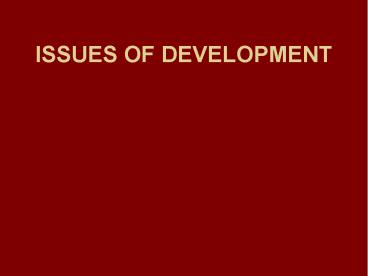ISSUES OF DEVELOPMENT - PowerPoint PPT Presentation
Title:
ISSUES OF DEVELOPMENT
Description:
... Less taxation Larger proportion of income spent on food Few large profits available for private developers Massive rural ... India , Puerto Rico ... Tourism Debt ... – PowerPoint PPT presentation
Number of Views:171
Avg rating:3.0/5.0
Title: ISSUES OF DEVELOPMENT
1
ISSUES OF DEVELOPMENT
2
What follows tend to apply to most LEDCs, but
not to all.
3
Access to Food
- Enough grain is produced to feed everyone more
than 3000 calories a day. - MEDCs dump food rather than sell it for a price
that is too low. - There have never been so many people suffering
from starvation or malnutrition than now.
4
Why?
- It is not being distributed effectively.
5
(No Transcript)
6
Reasons
- The producer sells to the person that will pay
the highest price.
7
- Food aid
8
Although food production per capita is
increasing in most parts of the world, it is
declining in Africa.
9
Why?
- Growing population
10
- Characteristics of farming
11
- The impact of agricultural reforms has not been
felt
12
Characteristics of farming
- Subsistence farming (no specialization)
- Traditional farming methods (broadcasting seeds,
wooden ploughs and animal power) - Poor storage facilities (insect pests)
- Small divided landholdings
- Absentee landlords
- Agribusiness companies encourage commercial crops
- Smaller number of people engaged in agriculture
13
Some countries have been more successful
- (Green Revolution)
- H.Y.V.s
- Irrigation schemes
- Chemical pesticides and fertilizers
- Mechanisation
14
Access to Shelter
- Shortage of accommodation is one of the
most common characteristics of cities in LEDCs
due to - Less taxation
- Larger proportion of income spent on food
- Few large profits available for private
developers - Massive rural-urban migration (shanty towns)
15
Access to Health and Education
16
Increased health risk
- More travel opportunities
- Overcrowding and poverty
- Poor water quality
- Lack of toilets
- Malaria (cannot afford draining swamps, rice
fields) - Bilharzia
17
Industrialisation
- Labour-intensive, not capital-intensive
- Import substitution
- Export processing zones (EPZs) - offering tax
holidays, low interest loans, cheap labour,
exemption from normal import taxes and duties and
assistance). India, Puerto Rico. - Special Economic Zones (SEFs). China
- Tourism
18
Debt
- Debt-trap (sometimes more than aid)
- Terms of trade has turned on the
- LEDCS (slower rise in price on raw
- materials than manufactured goods)
19
Ecologically Sustainable Development
- Several phases of the study of development
since World War II.
20
Structural change phase (the 1940s to the 1960s)
- Rostow
- The pathway to development was seen as the route
followed by Western Europe and North America
during the Industrial Revolution. - Five stages
- - traditional society - economic take-off -
maturity - high mass consumption
21
Dependency approach (1970s)
- Seeks to explain global patterns of development
- China, Vietnam, Tanzania and Cuba followed
different strategies. - Core-periphery model (unequal distribution of
power - colonization, transnational companies
encourage unprofitable raw materials) - Growth poles (where economic and political power
is concentrated)
22
Neo-liberal counter-revolution (the 1980s)
- Free market economics
- Industries in LEDCs should compete effectively or
close down. - Competed to attract foreign investment to
introduce modern technology to upgrade
inefficient industries.
23
Sustainable development (the 1990s)
- The Brundtland Report
- development which meets the needs of the present
without compromising the ability of future
generations to meet their own needs - So development that increases pollution, reduces
the resource base, reduces biodiversity or
changes the global environment is unacceptable
because it cannot be sustained in the long-term.
24
Identifies barriers to development
- Heavy reliance on fossil fuels
- (acid rain, global warming, deforestation,
health problems, TNCs more powerful than
nation-states).
25
- 2. Population growth
- (Development is only possible if population
grows in a way that is in harmony with the
changing productive capacity of the worlds
ecosystems).
26
- 3. Lack of a strong institutional framework to
oversee the process of development, in other
words of ecological and environmental
decision-making). - (Governments often argue that concern for the
environment is a luxury enjoyed by those who are
already wealthy).































